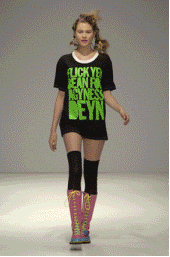Understanding Seelye: A Textual Analysis
Friday, February 20, 2009 10:38 AM
Understanding Seelye: A Textual Analysis
*this is the draft of my writing assignment, not yet complete. this is so hopeless...
Seelye, Katharine Q. “Lurid Numbers on Glossy Pages! (Magazines Exploit What Sells)” The Norton Field Guide to Writing with Readings. Eds. Richard Bullock & Maureen Daly Goggin. New York, London W.W. Norton & Company 2007. 525-529.
“A trip to the newsstand these days can be a dizzying descent into a blizzard of numbers”, says Katherine Q. Seelye, author of “Lurid Numbers on Glossy Pages! (Magazines Exploit What Sells!). In this article, the author explored the wonders numbers can do in magazine sales and how people yield to this number tactics. She claims that in magazine publication, number sells.
Seelye analyzes that most of this publications are aimed at women. “Service” publications especially, are filled with random tips and trends that will surely catch women’s attention. She states that editors used numbers as a selling point while readers find all the information they want in the magazine. Men’s magazines too, according to Seelye are buying the numbers racket. She illustrates how editors used catchy phrases and tips to get men’s attention, one of the schemes used are polls. Seelye warns readers that polls can sometimes be mistaken as interviews. In addition, Seelye reveals that editors sweat to find out the perfect numbers but there is no solution, it is all due to chance.
The author also points out that odd numbers are far more believable that even numbers. Odd numbers speaks authenticity, she relates from an interview with an editor. She assesses that editors insists that they use numbers that their writers actually find in their reporting. And they said that number 7 have a certain appeal while 13 is to be shunned. The size of the numbers however depends on the subject matter, reports the author. She finds that smaller numbers are used for serious matters like exercise tips, and bigger numbers are fine for something that says value without saying work.
Most editors test their magazine covers in focus groups to find which cover is more alluring to customers, says Seelye. She reports that the winning cover is almost always the one with large numbers printed on it. Numbers sticks out and draw the eye on monthly magazines, which aid the publishers’ battle with celebrity magazine. The author alleges that the biggest force that monthly magazine are dealing with is celebrity magazines. “You are not competing with other people’s numbers, you’re competing with Brad and Angelina and babies” quotes Seelye from a statement given by Kate White, editor of Cosmopolitan (p.527).
Sex still sells, claims the author, especially when confounded with celebrities. But in front of those glamorous celebrity photos, still stand the numbers. She describes how Glamour magazine features Sarah Jessica Parker’s photo on the cover, surrounded by numbers. The author finds that magazine editors used numbers to give readers something to focus on against the busy background.
However, numbers are more than just a graphic device, says Seelye as she notes that people are busy, and because of that, a quick, entertaining and informative read is ideal. She also explains that editors also use numbers to tell their readers what they have found and to alert them about the editor’s expertise, without wasting their reader’s time, since internet is also a powerful device in getting massive informations. The author relates that although some editors are trying to drop their numbers use, readers are still looking for numbers according to research, which shows that numbers really sell.
Seelye points out the difference between newsstand and subscription sales. According to her, newsstand sales are more money-spinning than subscriptions, because publishers find their new customers in newsstands, while subscribers already know what they want and has already subscribed, and probably at a discount. The author relates that still; newsstands sales have their own problems. It become more crowded and promotional space at checkout counters have become more expensive. Because of this, some editors start to produce separate magazine covers, one for newsstand and one for subscription. “On the newsstand, the cover is acting as a poster, an ad for what’s inside, the loyal reader is looking for what makes the magazine exceptional” Seelye quotes Glenda Bailey, editor of Harper’s Bazaar (p. 528).
In an interview with some magazine readers, Seelye finds that they also look for numbers, particularly in rankings and ratings. She relates how readers used numbers as a point system and to let them evaluate things quickly. But the author reveals that editors admit that they still use numbers even if they have already burned out.
*this is the draft of my writing assignment, not yet complete. this is so hopeless...
Seelye, Katharine Q. “Lurid Numbers on Glossy Pages! (Magazines Exploit What Sells)” The Norton Field Guide to Writing with Readings. Eds. Richard Bullock & Maureen Daly Goggin. New York, London W.W. Norton & Company 2007. 525-529.
“A trip to the newsstand these days can be a dizzying descent into a blizzard of numbers”, says Katherine Q. Seelye, author of “Lurid Numbers on Glossy Pages! (Magazines Exploit What Sells!). In this article, the author explored the wonders numbers can do in magazine sales and how people yield to this number tactics. She claims that in magazine publication, number sells.
Seelye analyzes that most of this publications are aimed at women. “Service” publications especially, are filled with random tips and trends that will surely catch women’s attention. She states that editors used numbers as a selling point while readers find all the information they want in the magazine. Men’s magazines too, according to Seelye are buying the numbers racket. She illustrates how editors used catchy phrases and tips to get men’s attention, one of the schemes used are polls. Seelye warns readers that polls can sometimes be mistaken as interviews. In addition, Seelye reveals that editors sweat to find out the perfect numbers but there is no solution, it is all due to chance.
The author also points out that odd numbers are far more believable that even numbers. Odd numbers speaks authenticity, she relates from an interview with an editor. She assesses that editors insists that they use numbers that their writers actually find in their reporting. And they said that number 7 have a certain appeal while 13 is to be shunned. The size of the numbers however depends on the subject matter, reports the author. She finds that smaller numbers are used for serious matters like exercise tips, and bigger numbers are fine for something that says value without saying work.
Most editors test their magazine covers in focus groups to find which cover is more alluring to customers, says Seelye. She reports that the winning cover is almost always the one with large numbers printed on it. Numbers sticks out and draw the eye on monthly magazines, which aid the publishers’ battle with celebrity magazine. The author alleges that the biggest force that monthly magazine are dealing with is celebrity magazines. “You are not competing with other people’s numbers, you’re competing with Brad and Angelina and babies” quotes Seelye from a statement given by Kate White, editor of Cosmopolitan (p.527).
Sex still sells, claims the author, especially when confounded with celebrities. But in front of those glamorous celebrity photos, still stand the numbers. She describes how Glamour magazine features Sarah Jessica Parker’s photo on the cover, surrounded by numbers. The author finds that magazine editors used numbers to give readers something to focus on against the busy background.
However, numbers are more than just a graphic device, says Seelye as she notes that people are busy, and because of that, a quick, entertaining and informative read is ideal. She also explains that editors also use numbers to tell their readers what they have found and to alert them about the editor’s expertise, without wasting their reader’s time, since internet is also a powerful device in getting massive informations. The author relates that although some editors are trying to drop their numbers use, readers are still looking for numbers according to research, which shows that numbers really sell.
Seelye points out the difference between newsstand and subscription sales. According to her, newsstand sales are more money-spinning than subscriptions, because publishers find their new customers in newsstands, while subscribers already know what they want and has already subscribed, and probably at a discount. The author relates that still; newsstands sales have their own problems. It become more crowded and promotional space at checkout counters have become more expensive. Because of this, some editors start to produce separate magazine covers, one for newsstand and one for subscription. “On the newsstand, the cover is acting as a poster, an ad for what’s inside, the loyal reader is looking for what makes the magazine exceptional” Seelye quotes Glenda Bailey, editor of Harper’s Bazaar (p. 528).
In an interview with some magazine readers, Seelye finds that they also look for numbers, particularly in rankings and ratings. She relates how readers used numbers as a point system and to let them evaluate things quickly. But the author reveals that editors admit that they still use numbers even if they have already burned out.


